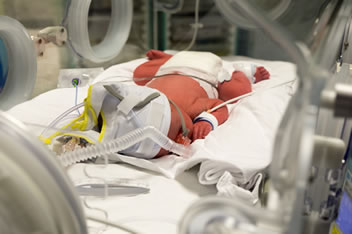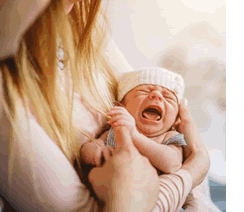Acute Treatment / Prevention
Acute Treatment
 The first approach to treatment is to treat any life-threatening issue. The most common emergency treatments for a child who has been shaken is providing breathing support and surgery to stop bleeding in the brain. Surgery may also be necessary to evacuate a hematoma.
The first approach to treatment is to treat any life-threatening issue. The most common emergency treatments for a child who has been shaken is providing breathing support and surgery to stop bleeding in the brain. Surgery may also be necessary to evacuate a hematoma.
Here is the summary of treatment recommendations from the Update on the 2012 guidelines for the management of pediatric traumatic brain injury – information for the anesthesiologist.
- Monitor ICP and CPP pressures; brain oxygen monitoring possible (Level III)
- Hyperosmolar therapy using saline (Level III)
- Avoid hyperventilation (Level III)
- Moderate hypothermia (Level II)
- CSF drainage and/or lumbar drain to reduce elevated ICP (level III)
- Barbiturate therapy (Level III) but no corticosteroids (Level II)
- Etomidate, thiopental to reduce intracranial hypertension but no propofol or antiseizure therapy (Level III)
- Decompressive craniectomy (Hardcastle, Benzon, & Vavilala, 2014). remains incomplete. We know
from studies of lucid dreaming (Godwin, 1994)
*Evidence Levels; Level I Experimental design; Level II Quasi-experimental studies; Level III Descriptive, correlational, qualitative studies; Level IV Opinion of experts, authorities, consensus panels; clinical practice guidelines; Level V Non-research evidence; literature reviews, quality improvement, case reports.
Prevention
The main approach to preventing Abusive Head Trauma to date is to provide education about the dangers of shaking infants, how to keep caregivers can keep an infant safe when coping with crying and other difficult behaviors and, to a lesser degree, interventions for excessive crying.
Altman et al (2011) reported the results of an educational program on AHT delivered by maternity nurses in 20 hospitals. The attendees were given a brochure on AHT, a video, how to prevent AHT and asked to sign an acknowledgement of receiving this information with plans to show it to other caregivers of their children.
Before the program 14 children in a 5-year period were admitted with AHT (2.8 cases a year). After the program 2 children were admitted in a 3-year period (0.7 injuries a year).
Allen (2014) analyzed 10 studies of intervention that targeted prevention of AHT by presenting information about AHT and normalizing infant crying behaviors. In all the studies the parents were taught the following: why infants cried, how to calm the infants, ways to cope with inconsolable infants, and how to develop a plan for what to do to cope. Of the 10 studies only 2 reported incidences of pre and post intervention frequency of AHT. Those two indicated a statistically significant decrease in incidence after the education program.
The following You Tube video was used in a number of studies. https://www.youtube.com/watch?v=CjyhfIZKmSg
Many of the education programs for parents about AHT include:
- Presenting a realistic versus idealistic descriptions of crying pattern of babies
- Identifying approaches to calm a baby such as checking if the baby is wet, offering a pacifier, talking softly, walking with a stroller, going for a drive in the car.
- Describing what to do if the parent is upset and losing control, such as putting the baby in a safe place and taking a break, calling a friend, relative or even calling a helpline for support.
Crying in infancy
 The term Period of Purple Crying, which stands for peak, unexpected crying which resists soothing, a pain-like face, long lasting, and occurring in the late afternoon or evening, was designed to help parents understand infant crying during this time is a normal developmental phase. The crying does not mean the parents are doing anything wrong. This Purple Crying occurs at about 2 weeks of age until the 3 to 4 month period. The amount of crying varies with the infant. During this time the babies are relatively inconsolable. Parents describe these times as the infant, crying, crying and crying.
The term Period of Purple Crying, which stands for peak, unexpected crying which resists soothing, a pain-like face, long lasting, and occurring in the late afternoon or evening, was designed to help parents understand infant crying during this time is a normal developmental phase. The crying does not mean the parents are doing anything wrong. This Purple Crying occurs at about 2 weeks of age until the 3 to 4 month period. The amount of crying varies with the infant. During this time the babies are relatively inconsolable. Parents describe these times as the infant, crying, crying and crying.
.jpg)
Blom et al (2009) recommends parents provide regularity and uniformity in daily infant care with a reduction in stimulation to reduce crying. Also swaddle infants during sleep. They believe a stable sleep-wake rhythm will reduce crying. Van Sleuwen et al (2007) reviewed several articles on swaddling to test its effectiveness. They found swaddled infants arouse less and sleep longer. Babies with excessive crying, cried less. Some adverse effects include hyperthermia when misapplied. The prone position when swaddled can increase the incidence of SIDS. Parents need to stop when infants attempt to turn. Tight swaddling can increase respiratory infections.
Instant Feedback
Purple Crying occurs at about 2 weeks of age until the 3 to 4 month period.
References
Allen, K. A. (2014). The neonatal nurse's role in preventing abusive head trauma. Adv Neonatal Care. 14(5), 336-42.
Altman, R.L., Canter, J., Patrick, P.A., Daley, N., Butt, N.K. & Brand, D.A. (2011). Parent education by maternity nurses and prevention of abusive head trauma. Pediatrics. 128(5), 1164-72.
Barr, R. G. (2014). Crying as a trigger for abusive head trauma: A key to prevention. Pediatric. Radiology, 44, 59 -64.
Blom, M. A., Van Sleuwen, B. E., De Vries, H., Engelberts, A. C. & L’Hoir, M. P. (2009). Health care interventions for excessive crying in infants: Regularity with and without swaddling. Journal of Child Health Care, 13, 161–176.
Hardcastle, N., Benzon, H.A. & Vavilala, M.S. (2014). Update on the 2012 guidelines for the management of pediatric traumatic brain injury-information for the anesthesiologist. Pediatr Anesth. 24, 703–10.
van Sleuwen, B.E., Engelberts, A.C., Boere-Boonekamp, M.M., Kuis, W., Schulpen, T.W. & L'Hoir, M.P. (2007). Swaddling: a systematic review. Pediatrics. 120(4), 1097-106.
©RnCeus.com
 The first approach to treatment is to treat any life-threatening issue. The most common emergency treatments for a child who has been shaken is providing breathing support and surgery to stop bleeding in the brain. Surgery may also be necessary to evacuate a hematoma.
The first approach to treatment is to treat any life-threatening issue. The most common emergency treatments for a child who has been shaken is providing breathing support and surgery to stop bleeding in the brain. Surgery may also be necessary to evacuate a hematoma.  The term Period of Purple Crying, which stands for peak, unexpected crying which resists soothing, a pain-like face, long lasting, and occurring in the late afternoon or evening, was designed to help parents understand infant crying during this time is a normal developmental phase. The crying does not mean the parents are doing anything wrong. This Purple Crying occurs at about 2 weeks of age until the 3 to 4 month period. The amount of crying varies with the infant. During this time the babies are relatively inconsolable. Parents describe these times as the infant, crying, crying and crying.
The term Period of Purple Crying, which stands for peak, unexpected crying which resists soothing, a pain-like face, long lasting, and occurring in the late afternoon or evening, was designed to help parents understand infant crying during this time is a normal developmental phase. The crying does not mean the parents are doing anything wrong. This Purple Crying occurs at about 2 weeks of age until the 3 to 4 month period. The amount of crying varies with the infant. During this time the babies are relatively inconsolable. Parents describe these times as the infant, crying, crying and crying. .jpg)